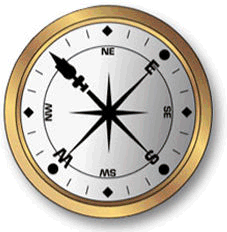Traditional Korean Wedding
|
| In Korea, the marriage between a man and
woman represents the joining of two families, rather than the joining of
two individuals. As such, the event was often called Taerye
(Great Ritual), and people from all over participated.
|
Steeped
in traditional Confucian values, the ceremonies and events
surrounding the actual marriage were long and elaborate, from
the pairing of the couple to the rituals performed after the
ceremony.
In the
traditional Korean marriage, the elders of the prospective bride and
bridegroom's families decided on all matters regarding the wedding,
including the decision of whether or not to marry their son and daughter
to each other.
|
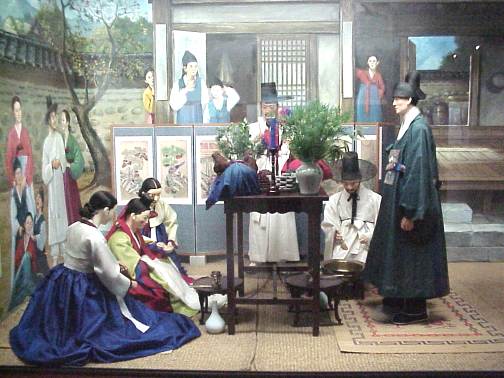
|
|
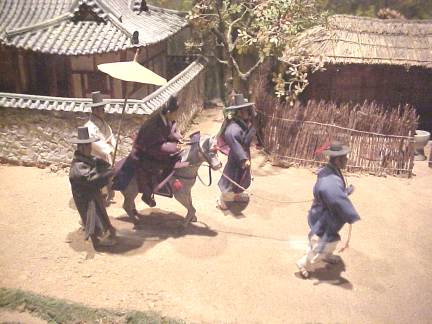
(Arrival of the bridegroom)
|
Napchae
(Date Setting)
After
confirming each family's decision to marry their son and
daughter through a matchmaker, the familiy of the
bridegroom-to-be sent the hour, day, month and year of his birth
by the lunar calendar (known as the Four Pillars) to the family
of the bride-to-be and, in return, her family informed the
family of the bridegroom-to-be the date of their wedding. The
family of the future bridegroom then sent a letter of marriage
and wedding presents to the family of the future bride.
|
Napp'ae
(Exchanging Valuables)
Before the wedding, the groom's
family sent presents to the bride and her family in a box called
a Ham. Additionally, the Hamjinabi (person who delivered
the Ham) and a small group of close friends of the groom also
took a pot of Bongch'i Deok (red bean rice cake) from the
groom's family. The bride's family would have a small party for
the group, offering them food and drink for their efforts. The
ceremony of delivering the Ham has evolved into a major event
for friends of the groom, with the bearers "selling"
the contents of Ham to the bride's parents.
The Ham usually contained 3 items. The Honseo (marriage
paper), wrapped in black silk, specified the name of the sender
and the purpose (marriage) of sending. It symbolized the
dedication of the wife to only one husband. The wife was to keep
this document with her forever, having it buried with her when
she died. Ch'aedan was a collection of red and blue
fabrics, used to make clothing. The blue fabrics were wrapped
with red threads, while the red fabrics were wrapped with blue
threads. The two colors represented the philosophy of Eum/Yang (Yin/Yang). The
Honsu was a collection of other valuables for
the bride from the groom's parents.
|
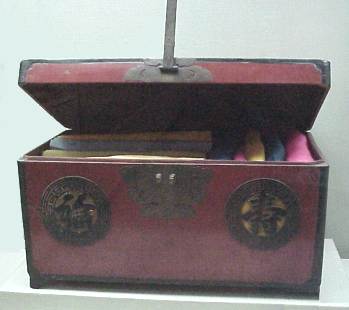
(Wedding Box, Ham)
Wedding boxes, bridal chests and rice chests
where often elaborated with beautiful Chinese characters which can be found on prominent places and give each
item a special touch. |
|
Wooden Goose/Wedding
Ducks (Kireogi)
|
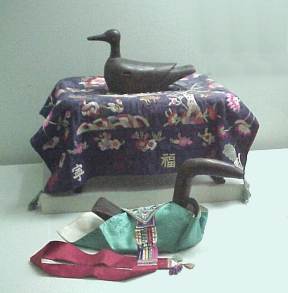 |
A pair of wild geese made from wood
represent the new husband and wife. In the Jeonanrye part of the marriage ceremony, the groom gives a single kireogi
to his mother-in-law. The geese symbolize several virtues that the
couple should follow in their married life:
- Wild geese keep the same partner for life. Even of one dies, the
other will not seek a new partner for the rest of his or her life.
- Wild geese understand hierarchy and order. Even when flying, they
maintain structure and harmony.
- Wild geese have the nature to leave their existance wherever they
go. People should leave a great legacy for their descendants when
they leave this world.
|
In a traditional Korean
wedding which was held in the bride's house, a bridegroom's first act
after arriving at the bride's house was to offer a wooden goose to the
bride's family as a token of lifelong fidelity which was the beginning
of the wedding ceremony.
Still nowadays, wooden ducks are nice wedding presents appreciated not
only in Korea but also in the western world.
|
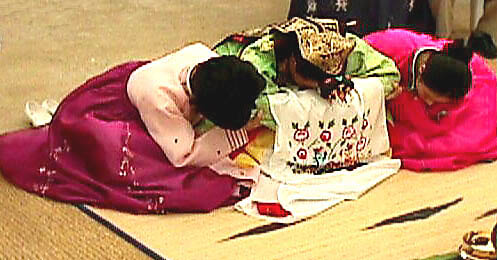 |
Gyobaerye
(Bowing)
This often marked the first time that the bride and groom saw each
other. The groom and bride each had two attendants who helped
them throughout the ceremony. First, the groom walked to the
east side of the wedding table.
|
|
| Then the bride walked to the west end.
The groom's helpers spread a carpet or mat out for the groom, then the
bride's helpers did the same for the bride. The bride and groom then
faced each other across the wedding table. The helpers washed the hands
of the bride and groom. The washing of their hands symbolized cleansing
themsleves for the ceremony. With the aid of her helpers, the bride
bowed twice to the groom. With the aid of his helpers, the groom bowed
back once to the bride. The bride then bowed two more times to the groom,
who bowed back once more. They finished by kneeling down and facing each
other. The bowing represented the promise of commitment to each other. |
| |
Eum/Yang
(Yin and Yang)
 Marriage
represented the perfect union and balancing of the two primary elements
of the world: Eum, the dark,
female element; and Yang, the
bright, male element ("yin" and "yang"). Often, the
marriage ceremony took place at dusk, representing a balance between
light (day) and darkness (night) The color blue stands for Eum,
while red represents Yang. Marriage
represented the perfect union and balancing of the two primary elements
of the world: Eum, the dark,
female element; and Yang, the
bright, male element ("yin" and "yang"). Often, the
marriage ceremony took place at dusk, representing a balance between
light (day) and darkness (night) The color blue stands for Eum,
while red represents Yang. |
| |
Chickens
| A
male and female chicken (one wrapped in a blue cloth, the other in a red
one) sit on or under the wedding table. One meaning is the symbolism
associated between roosters and the morning. The crowing of the rooster
marked the beginning of the day, a bright, fresh start, just like the
marriage should be. The crowing of the rooster also told the evil
spirits that day was coming and they had to disappear. |
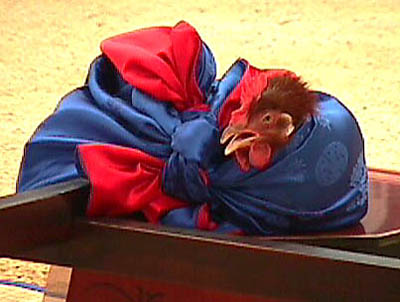 |
The rooster in
the wedding ceremony marks a hope that evil spirits will go away and not
trouble the new couple. A secondary meaning represents the hopes that the couple will have many
children, very important in a traditional agrarian society. As
productive chickens made many eggs, thus should the new bride produce
many children.
|
Hapgeunrye (Drinking)
| This part of the ceremony had two main
variations, due to regional differences. The first variation had the couple drinking from the same
cup, with their assistants passing it back and forth between bride and
groom. The second variation had them drinking from separate halves of a
gourd. The drinking signified the destiny of the new husband and
wife, as well as their harmony together. Using two halves of the same courd further symbolized that the bride and groom each made up one half and only together could they be considered
whole. |
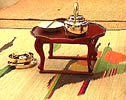 |
First, one of the helpers poured alcohol into a small cup for the groom, who then drank it. Another helper poured for the bride who sipped it or only pretended to drink. The groom's helper then poured into the cup again (or used the gourd in the other variation) and the groom drank again. The bride's helper poured again, with the bride sipping or pretending to drink again. Finally, the grrom and bride joined together and bowed three times: once to their parents, once to their ancestors, and once to the
guests.
|
Modern Weddings
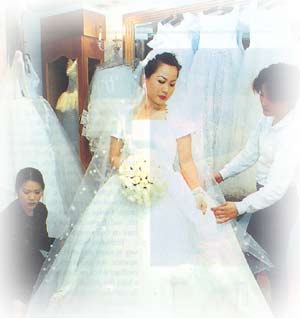 |
Although Koreans have kept several
aspects of the traditional ceremony, most modern ceremonies resemble
Western marriage ceremonies more than traditional Korean ones. However,
many folk villages and museums across the country regularly perform
ceremonies to keep the traditions alive. |
|
|
  |
Daniela Jost
Asian Rarities, Ukiyo-e, Ikebana and Japanese and Chinese Stone Lantern
|
|
Copyright ©
1998-2023 by Daniela Jost, All Rights Reserved.
This page was last updated May 2023 |


 Marriage
represented the perfect union and balancing of the two primary elements
of the world: Eum, the dark,
female element; and Yang, the
bright, male element ("yin" and "yang"). Often, the
marriage ceremony took place at dusk, representing a balance between
light (day) and darkness (night) The color blue stands for Eum,
while red represents Yang.
Marriage
represented the perfect union and balancing of the two primary elements
of the world: Eum, the dark,
female element; and Yang, the
bright, male element ("yin" and "yang"). Often, the
marriage ceremony took place at dusk, representing a balance between
light (day) and darkness (night) The color blue stands for Eum,
while red represents Yang.





